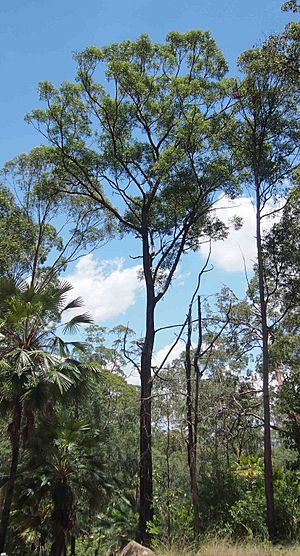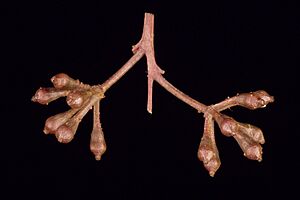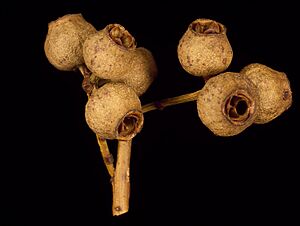Bailey's stringybark facts for kids
Quick facts for kids Bailey's stringybark |
|
|---|---|
 |
|
| Scientific classification | |
| Genus: |
Eucalyptus
|
| Species: |
baileyana
|
Eucalyptus baileyana, often called Bailey's stringybark, is a tree found only in certain parts of eastern Australia, mostly near the coast. It has rough, stringy bark on its trunk and main branches. Its adult leaves are shaped like a spear. The tree produces groups of seven flower buds, which open into white flowers. These flowers have stamens (the parts that make pollen) arranged in four bundles. After flowering, it grows urn-shaped or round fruits.
Contents
What is Bailey's Stringybark Like?
Bailey's stringybark is a tall tree. It can grow up to 25–40 metres (82–131 ft) high. It also has a special woody swelling at its base called a lignotuber. This helps the tree regrow after a fire.
Its bark is rough and stringy. It can be reddish-brown or dark brown to black. Young plants and new shoots that grow after damage (called coppice regrowth) have hairy, often bright pink tips. Their leaves are spear-shaped, about 60–150 mm (2.4–5.9 in) long and 25–75 mm (1–3 in) wide.
Adult leaves are also spear-shaped or slightly curved. They are about 90–165 mm (3.5–6.5 in) long and 10–25 mm (0.4–1 in) wide. These leaves grow on a stalk called a petiole, which is about 12–20 mm (0.47–0.79 in) long. One side of the leaf is dark green, and the other side is a lighter green.
The flowers grow in groups of seven. They appear in the leaf axils, which are the angles where a leaf joins the stem. Each group of flowers grows on an unbranched stalk called a peduncle, about 15–25 mm (0.59–0.98 in) long. Each individual flower bud sits on a smaller stalk called a pedicel, about 3–9 mm (0.12–0.35 in) long.
Mature flower buds are shaped like a club or a spindle. They are about 5–8 mm (0.20–0.31 in) long and 3–5 mm (0.1–0.2 in) wide. Each bud has a cap called an operculum, which is rounded or cone-shaped with a small point.
Bailey's stringybark mainly flowers from October to January. Its flowers are white, and their stamens are grouped into four bundles. The fruit is a woody, urn-shaped or somewhat round capsule. It is about 9–15 mm (0.35–0.59 in) long and 8–17 mm (0.3–0.7 in) wide. The parts that open to release seeds (called valves) are level with the rim or slightly above it.
How Did it Get its Name?
The scientific name Eucalyptus baileyana was first officially described in 1878. This was done by a scientist named Ferdinand von Mueller. He published his description in a book called Fragmenta Phytographiae Australiae.
The "baileyana" part of the name honors Frederick Manson Bailey. He was the person who collected the first example of this tree (called the type specimen) near Moreton Bay.
Where Does Bailey's Stringybark Grow?
Bailey's stringybark often grows on hills, ridges, and low coastal areas. It is usually found in dry sclerophyll forests or woodlands. These areas have sandy soils that don't have many nutrients and are quite shallow, often over sandstone.
In New South Wales, you can find it along the coast, north of Coffs Harbour. It also grows across the border into Queensland. It forms a narrow strip of trees that is usually less than 80 kilometres (50 mi) from the coast. It reaches as far north as Brisbane and sometimes even further north, near the Blackdown Tableland.
Some other trees that often grow near Bailey's stringybark include Eucalyptus planchoniana, Eucalyptus cloeziana, Eucalyptus citriodora, Eucalyptus gummifera, and Eucalyptus intermedia.
Is it Endangered?
No, Bailey's stringybark is not considered endangered. In Queensland, the government has classified it as being of "least concern" under the Nature Conservation Act 1992. This means there are plenty of these trees around, and they are not currently at risk of disappearing.



